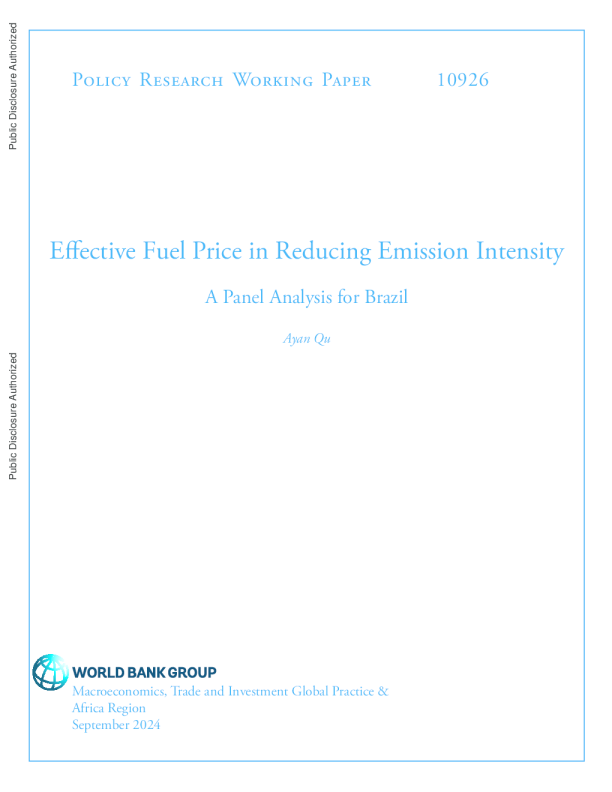降低排放强度的有效燃料价格:巴西的面板分析
 AI智能总结
AI智能总结
10926 有效燃料价格在降低排放强度中的作用巴西:面板分析 Ayan Qu 宏观经济学、贸易与投资全球实践与非洲区域 September 2024 政策研究工作论文 10926 摘要 本文研究了作为燃料碳税指标的燃料价格增量变化在降低巴西道路交通运输排放强度方面的有效性,通过2010年至2020年在联邦单位层面的面板分析进行探讨。在分析巴西机动车燃料市场,包括其产品、参与者和外部因素时,本文提供了描述性见解。论文提出了多种面板分析模型变体,并重点关注动态双向分析。 基于统计结果建立的固定效应模型。研究发现:(1)柴油价格对降低排放强度的显著性和稳健性影响最为显著;(2)柴油价格的短期和长期弹性分别为−0.74和−2.06;(3)实体和时效效应均显著,其中2020年在所有估计模型中对降低排放强度均具有一致的影响。 本文是非洲区域宏观经济、贸易与投资全球实践和首席经济学家办公室的产物。它是世界银行为提供其研究成果的开放访问并贡献于全球发展政策讨论的一项更大努力的一部分。政策研究工作论文也发布在http://www.worldbank.org/prwp网站上。作者可通过aqu@worldbank.org联系。 政策研究工作报告系列传播正在进行中工作的发现,以促进关于发展的思想交流问题。本系列的目标之一是快速发布研究成果,即使报告的呈现不够完美。论文包含以下内容:作者姓名应相应引用。本文中表述的发现、解释和结论完全是作者本人的观点。作者的观点。他们不一定代表国际重建与发展银行/世界银行的观点。其附属机构,或世界银行执行董事或他们所代表的政府。 Ayan Qu有效燃油价格在降低排放强度中的作用:巴西的分组分析 关键词:燃料价格;排放强度;交通;面板分析;巴西 JEL 分类:Q41; Q58; H23; C23 致谢 I.引言 交通运输是巴西温室气体(GHG)排放的主要来源,而持续的技术发展和可再生能源转型为该行业的脱碳提供了巨大机遇。在农业和林业(及其土地利用)之后,交通运输是国家GHG排放的主要来源,约占能源消费排放的一半(SEEG 2022)。该国的清洁电力矩阵解释了电力低排放强度(巴西CCDR;世界银行2021年),但尚未充分惠及仅占极小份额的电动汽车(2018年为0.02%,但根据国际能源署的数据,到2023年已迅速增至3%)。同时,该国是全球生物燃料(特别是乙醇和生物柴油)的先驱,这些燃料的排放因子低于化石燃料,其生物质生产(如果非源自森林砍伐)有助于减排。交通运输的总GHG排放主要由柴油和汽油燃烧产生的排放所主导。 气候变化不平等也是另一个担忧,这种现象同样存在于巴西,而生物燃料市场有助于农业和能源部门的收入趋同。在较不发达的例如: 区域(北方和东北方区域)排放较少的排放量(图1但同时也承担更高的成本,无论是在当前燃油价格方面(图1)以及潜在的气候变化损害。减排措施,如碳税,是渐进式的,并且可以通过提高收入较高和排放较多的地区的成本来帮助解决这种气候不平等。同时,生物燃料市场的开发扩大了对糖 cane 和大豆等农产品的需求,进而增加了农民的收入,从而有助于弥合各行业间的收入差距。实际上,自1980年代以来,农业生产力与整个经济生产力的比率稳步提高,这与乙醇的引入相吻合,特别是在2010年代生物柴油引入之后。 随着碳税在激励清洁能源转型和应对气候变化不平等方面扮演着重要角色,本文提供了实证证据来回答关于以燃油价格上涨的增量变化为代理的碳税在巴西实现减排强度降低方面的有效性的研究问题。我们利用联邦单位(FU)层级和年度频率的交通部门燃油价格和排放强度的变化,在控制了实体和时间特定效应的情况下进行面板分析,以达到我们的估计目标。结果显示,燃油价格的边际增长,尤其是柴油价格的增长,有可能有助于在短期和长期降低排放强度。此外,排放强度是持久的,实体和时间效应都是显著的。值得注意的是,2020年表明,在各种估计模型中均存在一个一致的固定效应,即降低了排放强度。 本文的结构安排如下。第二节介绍了巴西燃料市场的典型事实,包括产品、参与者和外部因素。第三节回顾了相关文献。第四节描述了数据和元数据。第五节解释了估计燃料价格短期和长期排放强度弹性的实证策略。第六节讨论了结果和政策含义。最后一节得出结论。 注:以下数据为2022年柴油B、汽油C和乙醇的平均零售价格。 数据来源:巴西石油、天然气和生物燃料国家机构(ANP)。 II. 巴西交通运输燃料市场之风格事实 本节展示了巴西复杂的汽车燃料市场的关键特征,涉及产品、参与者、技术以及政策等方面。这些特征可能对排放强度产生重大影响,这是我们分析的目标,因此有助于我们的估算策略。 第二部分:一、产品:数量和价格 巴西的交通燃料市场多元化,其中存在多种燃料共存,包括引人注目的即 可再生能源生物燃料的份额。市场上存在四种主要的零售燃料(柴油油B、汽油C、水合乙醇,以及压缩天然气或CNG),其中一些是不同来源燃料的混合物()。表1). 虽然柴油油和汽油一直是消费最多的燃料,但从甘蔗生产的乙醇在第一次石油危机和“普罗-阿尔库尔”计划启动后不久就进入了市场。1乙醇最初被用作加到汽油中的无水乙醇,后来也被用作独立使用于纯乙醇动力车辆或灵活燃料车辆中的含水乙醇。无水乙醇和含水乙醇的合计消费量(按吨计)现在已增长到零售汽油C主要成分汽油A的大约三分之二。从2000年代中期开始,生物柴油进入市场,并且与柴油以不断增加的比例混合,形成柴油油B。2012年后,引入了一种含硫量远低于柴油油B的新变体S10柴油油。此外,天然气压缩(CNG)自1990年代以来就已存在,尽管目前数量相对较少,并且并非在所有燃油供应站都可供销售。 不同燃料的销售量呈现各种增长模式(图2),反映了经济条件、国内政策、国际市场和科技创新/采纳的影响。柴油油消费在时间上增长更为稳定,在经济衰退期间出现暂时下降。汽油消费随着中期波动而增长,部分反映了世界商品周期/石油危机。水乙醇在20世纪80年代快速增长,在90年代失去动力,之后在短期波动中再次呈上升趋势,这可能是由于政策激励和2003年引入的灵活燃料技术,该技术使乙醇能够替代汽油。天然气自2007/2008年以来增长停滞,在2013年被生物柴油超越,后者由于政策支持而继续增长。总体而言,这些燃料的总体量在2010年代中期之前一直增长,随后开始波动,与该国实际国内生产总值紧密对应。 数据来源:巴西能源平衡(BEN),EPE。 燃油价格,影响燃油消耗及其结果排放的另一个因素,呈现出空间和时间上的变化,我们将利用这些变化来理解作为燃油税替代物的燃油价格增量变化的影响。在巴西,最终消费者价格由生产商计费价格、联邦和州税以及分销成本组成。这些零售燃料价格因燃料类型、年份和地区而异()图3). 乙醇的价格分布更为广泛,可能是因为它由众多乙醇工厂供应。北部和东北部地区的发展程度较低,但燃料价格往往高于更富裕的东南部地区,部分原因是物流成本,从而导致燃料价格体系呈递进性。值得注意的是,2022年平均燃料价格最高的燃料供应区全部位于北部地区,即阿克里、罗赖马、帕拉和罗ンド尼亚,其次是东北部的四个燃料供应区,而圣保罗的平均燃料价格最低(图1)。此外,我们还在近几年看到名义燃料价格上涨,但在2022年末降至较低水平,因为联邦燃料税率暂时降至零以减轻通货膨胀的影响。 数据来源:ANP.注:数值为名义价格。 II.2. 参与者:生产者和消费者 该国的化石燃料生产集中,而生物燃料生产分散。由联邦政府控股的上市公司巴西石油公司(Petrobras)在石油和天然气生产方面长期占据垄断地位,直到近年来市场逐渐向新参与者开放。2020年,Petrobras实现了2720亿雷亚尔的净收入,是第二大参与者Shell BrasilPetroleo的10多倍。少数其他生产商占据较小的市场份额。在勘探和生产之后,原油由该国的18家炼油厂(ANP)进行精炼,然后送往分销商和零售商。另一方面,生物燃料的生产始于生物质农场,由383家乙醇工厂和49家生物柴油生产商(ANP)生产。在巴西,生物柴油主要例如: 由大豆(约70%)制成,其余部分来自动物脂肪(,牛肉废料)和植物油例如: ( ,棉籽油)。乙醇主要从甘蔗(约占85%)中生产,其余部分主要来自玉米和甜菜。虽然乙醇代表了总生物燃料生产中最大的份额(约占80%),但在近年来,生物柴油的生产增长速度更快。 汽车燃料直接由拥有车辆的居民和企业消耗,尽管程度上较轻,但也可能通过公共交通/共享交通影响更广泛的民众。根据巴西地理统计局(IBGE)近年来的数据,该国超过1.15亿辆车在超过2.13亿总人口和超过7600万户家庭之间共享,每人平均约为0.54辆车,每户1.5辆车。该国的平均人口年龄较年轻,全国超过37%的人口年龄低于18岁(获得驾驶执照的最低法定年龄),他们不会拥有车辆。车辆的区域分布也并不均匀,几乎一半的车辆分布不均。 西南地区注册的汽车数量占总数的百分之多少,而北方地区仅为百分之六(Senatran2021)。换句话说,通过税收增加汽车燃料价格将对那些没有车辆、更易受伤害的人群产生较小的负面影响。 II.3. 外部因素:技术和政策 除了价格因素,生物燃料的发展还受到技术进步的推动,并通过政府政策得到激励,包括财政工具。在生产方面,甘蔗是巴西最古老的作物之一。自16世纪以来,它就被用来生产糖。th世纪,乙醇作为该过程的副产品被生产出来。如今,巴西的蒸馏商可以改变糖和乙醇的相对生产量,从而增加乙醇生产对市场的灵活性。在需求方面,汽车在20世纪早期的引入。th20世纪开启了乙醇燃料的使用机会,这受到了一些地方政府的鼓励。直到第一次石油危机,以及即 1975年,巴西推出了第一个推广乙醇(“Pró-Álcool”)的国家级计划,当时巴西见证了第一批乙醇燃料生产浪潮。对能够使用纯水合乙醇的车辆的创新能力、税收豁免,以及对在汽油中混合无水乙醇的政策要求,都是推动乙醇需求增长并促进其增长的关键因素。到了1980年代末,乙醇燃料的体积已达到与汽油相似的水平,尽管在此之后,由于汽油增长速度更快,其增长速度被赶超。2003年引入的可消耗汽油和乙醇不同比例混合物的灵活燃料技术、化石燃料与生物燃料之间的税收差异,以及通过国家生物柴油生产和利用计划(PNPB)在柴油中混合生物柴油的要求,都有助于解释最近生物燃料的增长。巴西全国范围内的分销基础设施的可用性也是生物燃料市场的促进因素。 最近成立的巴西生物燃料政策(RenovaBio)特别针对燃料矩阵的碳强度。作为国家能源政策的一个组成部分,RenovaBio(第13576号法律)于2017年底通过,旨在促进生物燃料(特别强调可靠的供应)并减少燃料的排放,初始期限为10年。为实现这些目标,该政策依赖于一系列工具。将对燃料分销商实施强制性年度目标,以减少燃料矩阵的排放。目标的合规性将通过碳减排信用额度进行验证,这些信用额度部分基于生产的/进口的/交易的生物燃料量,可以在有组织的市场上进行交易。对于生物燃料的生产商/进口商,应发放基于生命周期评估的效率生产认证。某些收入也享有所得税优惠/免税。 第二部分:4. 目标:碳排放强度 排放强度,在此定义为从公路交通中产生的总排放量(t)除以总实际收入,是我们分析的目标宏观指标。此指标衡量了每单位收入增加产生的排放量,较小的数值通常更受欢迎。排放强度代表了I=PAT等式中影响经济活动环境影响的科技因素T。巴西的排放强度在20到120(t CO2e/百万实际收入R$)之间,发达区域如联邦区、里约热内卢和圣保罗的排放强度较低(。图 4以下各节将分析解释排放强度异质性的原因,即它在多大程度上是由燃料价格或其他与时间相关的因素所导致,这些因素混淆了燃料价格与排放强度之间的真实关系,并讨论燃料税在降低排放强度方面可能的有效性。 来源:巴西地理统计局(IBGE)、SEEG以及作者的计算。 第三部分 文献综述 总的来说,本文对通过“成本效益”方法正确设




